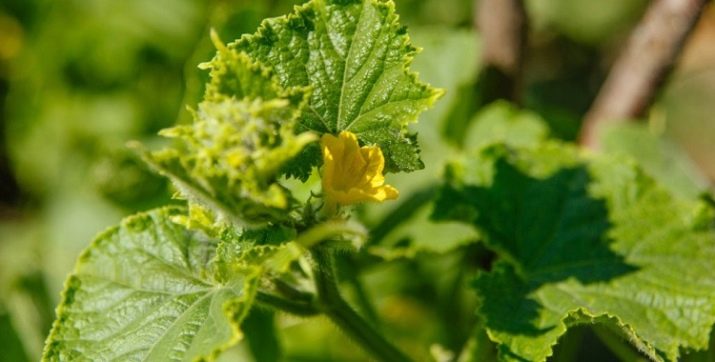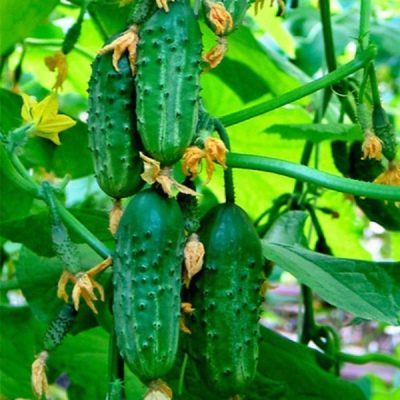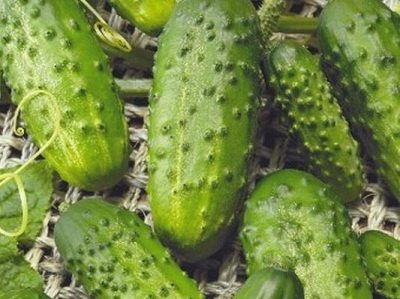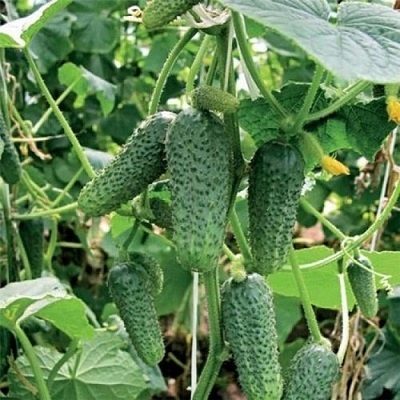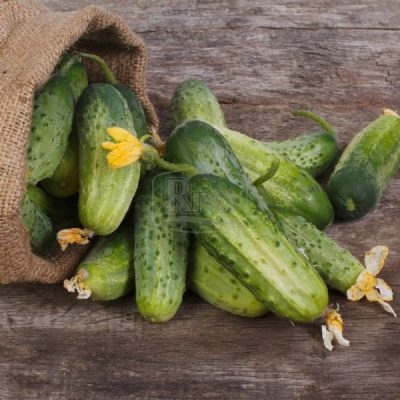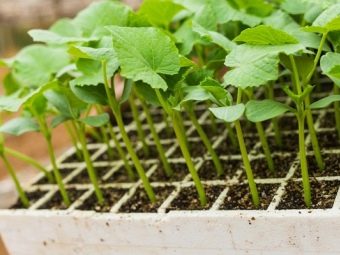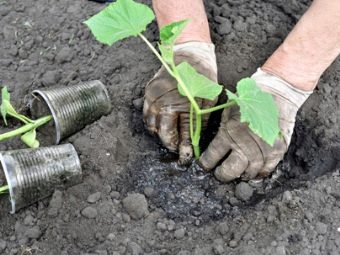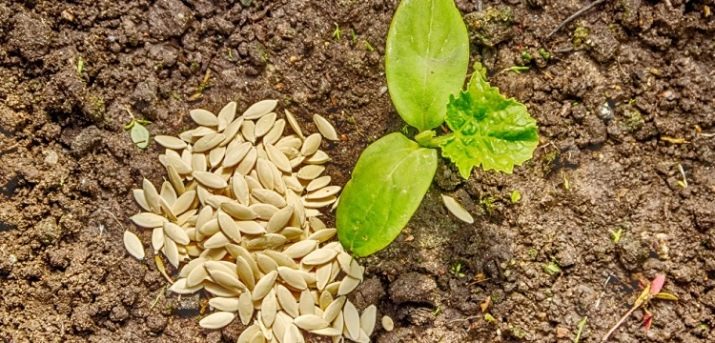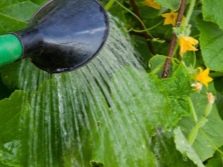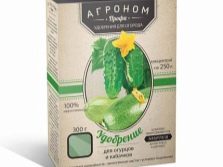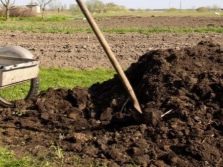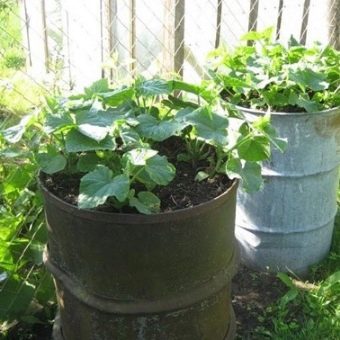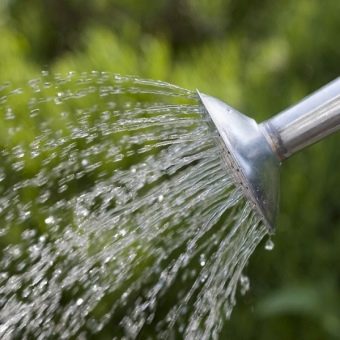Bush Cucumbers: Variety Description and Cultivation Rules
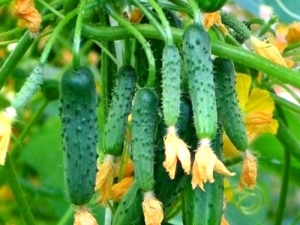
Everyone loves cucumbers grown in their summer cottage, because they have a special taste and aroma.But gardeners often face the following problem - cucumbers grow in long “lianas”, stretch, allow many side shoots. All these processes must be regularly monitored, otherwise they can significantly reduce the yield. Therefore, varieties of bush cucumbers, which possess several positive qualities for summer residents at once, were bred.
Distinctive features
Ordinary varieties of cucumbers grow very strongly - the length of the “lianas” reaches 3 meters, which cannot be said about bush plants. They look like compact bushes with a height of no more than 80 cm (depending on the variety may be even lower, you should pay attention to the description when buying seeds). At the same time, the bush practically does not allow lateral shoots, which greatly facilitates the care of the plant and is distinguished by high yield.
Bush cucumbers belong to the early ripening varieties. Fruits are usually medium-sized, convenient for salting and pickling. While ensuring optimum humidity and temperature conditions, the first cucumbers can be harvested as soon as 3 weeks have passed after the landing in the ground.
Another important characteristic of this vegetable is its taste. Spray cucumbers are aromatic, with a fresh smell and taste. The variety is versatile for use in cooking: the fruits are equally well manifest themselves both for pickling and for fresh consumption. Long enough to keep their freshness, well transported.
Based on the reviews of gardeners, it is possible to identify such a feature of bush cucumbers, as resistance to various diseases. This is due to the fact that the time of development and fruiting of the bush is less than that of an ordinary plant, therefore, most diseases simply do not have time to develop.
The fruits of this variety must be carefully monitored, as they tend to ripen very quickly. They overripe just as quickly, so it is advisable to harvest the crop every day. The yield of bush cucumbers is lower than that of ordinary ones, but the convenience is that the fruits ripen almost simultaneously.
Popular varieties
In order to find a suitable variety of bush cucumbers, It should be guided by several criteria on the basis of which it will be convenient to do:
- fruit ripening time;
- pollination method;
- the duration of fruiting;
- the influence of external factors on plant development;
- cultivation method - open ground or greenhouse.
Next, consider the varieties of bush cucumbers, which have gained special confidence from experienced farmers.
- "Kid". Suitable for cultivation in the open field, is a ripened variety. Shrubs of this variety begin to bear fruit 40 days after planting. Cucumbers "Kid" reach a length of no more than 10 centimeters, covered with pimples, the color of the fruit is rich green, the taste is completely absent bitterness. Have increased resistance to various fungi, powdery mildew. The variety is convenient for breeding, as it pollinates itself. Culture requires extremely frequent watering - 2 times a day.
- "Shorty". Suitable for growing outdoors only. Pollinated by bees. In comparison with the variety, “Kid” produces larger volumes of crop, but also has longer shoots. On average, fruiting begins 50 days after planting. Cucumbers have a normal, oblong shape, reach a length of 12 centimeters, covered with pimples. This variety is not recommended for pickles and marinating. Resistant to powdery mildew. In order to harvest a bountiful crop from the bushes of this variety, regular abundant feeding and watering are necessary.
- "Kustovoy". The variety under this name is grown in the open ground, bee-pollinating. Bushes begin to bear fruit after 45-50 days from the moment of disembarkation. The length of the mature fruit is about 12 centimeters, cucumber tuberculosis is mild, the peel is dark green. It is a sort of salad. The main difference of this variety is low demands on frequent and abundant watering. It has a high yield.The disadvantage of the variety is its susceptibility to powdery mildew, therefore, treatment from this disease is necessary.
- "Gift". Is an early ripe grade. Begins to bear fruit 50 days after planting. The fruits are prickly, dense, well suited for pickling and salting.
How to plant?
There are two options for planting cucumbers - seedlings and in the open ground. Each method has its own advantages. So, planting seedlings allows you to get the first harvest in the shortest possible time, to provide protection from possible frosts. Planting seeds in open ground will protect you from long-term care of the seedlings.
When choosing a soil for planting seedlings, it should be remembered that cucumbers love fertilizer: the soil should be fertile. When using your own seeds, before planting, they should be etched with nitrate-phosphate fertilizer (nitrophosphate) and stratified in the refrigerator for about 4 hours. All these measures have a positive effect on seed germination and plant resistance to diseases.
Seedlings can be planted both in individual containers and in a large box. The seed wells need to be watered well. After sowing, you can cover planting film and remove as soon as the shoots reach its height. The first shoots do not take long to wait: as a rule, they appear within a week. For successful germination, it is necessary to ensure favorable conditions - to keep the containers with plantings at a temperature of at least 20 degrees and water it abundantly.
For further planting of seedlings in open ground, you need to wait for the soil to warm up to 20 degrees. 2 weeks before planting, the bed must be prepared - apply fertilizer. Cucumbers are planted, if at least 4-5 true leaves appear in the seedlings, it takes about 20 days to form them.
For the first time, a greenhouse can be built for successful rooting in the ground and protection from undesirable low temperatures. The distance between the bushes in the row should be about 10 cm, between the rows - 45 cm. The first time after planting seedlings in open ground, we must carefully weed the rows between weeds, as they take a large amount of moisture from the soil.
When planting seeds immediately in open ground, it is better to take care that the soil is light and breathable. If your site is heavy soil, you need to mulch the planting peat. When planting seeds, it is necessary to cover them with a film, as the temperature difference in the open field can adversely affect the germination of seeds. Otherwise, further care of seedlings of the planting type and initially planted in open ground is no different.
Care
The first and most important step in the care of cucumber plants is regular watering. From the moment of planting the seedlings into the ground and before the formation of the first ovaries, it is necessary to ensure daily watering. When the first cucumbers begin to set, watering can be reduced to 1 time in 3 days. Watering is done in the early morning or evening hours, because cucumbers have very tender foliage, which can quickly burn. Water is recommended to take warm. Cucumbers are very responsive to fertilizer, so regular feeding will help to ensure a bountiful harvest and support the plants during their growth.
- The first fertilizer needs to be applied already 14 days after the appearance of the sprouts: complex phosphate-nitrate-potassium preparations are introduced.
- The following feeding is carried out 2 weeks after the first one; for this purpose, mineral compositions created specifically for cucumbers are used.
- Next, the plants are fed shortly before flowering. Since the bush varieties are early, this happens within 1.5 weeks after the second fertilizer. The third fertilizer is produced by humus or traditionally - manure.
- The fourth stage of fertilizing is the introduction of nitrophoska mixed with preparations for intensive growth of the ovaries, this stage is carried out a week after the formation of the first ovaries.
- The last feeding is carried out 1.5 weeks after the fourth, making specialized mineral fertilizers for cucumbers.
Fertilization is carried out correctly after irrigation, so that the substances evenly spread on the ground and do not damage the roots of the plant.
An interesting way of growing cucumbers, suitable for bush varieties, is planting them in a barrel. This method can protect plants from soil overcooling. The convenience of this method also lies in the fact that the density of planting in this case is large enough, you can save space on the beds and at the same time get a good crop of cucumbers, which will be at eye level.
In addition to abundant watering with warm water and fertilizers, the soil around the cucumbers should be regularly freed from weeds and loosened. This will protect plants from various diseases and improve the quality and quantity of the resulting crop. The leaves of cucumbers are quite tender, as are the roots, so at the time of the hot midday sun it will not be out of place to cover the plant from the scorching rays.
The main diseases that can still be found on bush cucumbers, despite their resistance to many diseases, are usually fungal in nature. It may be white rot, powdery mildew or cladosporia. Since a cluster plant has a short period of life, many diseases do not touch it for one simple reason - it ceases to bear fruit before the ailment has time to develop.
To protect the plants from the possible development of diseases, you need to follow the rules of crop rotation, process the seeds with a solution of manganese before planting (if they are collected and prepared independently from last year). It will be useful before planting seedlings in open ground to shed the prepared soil with boiling water.
The fungus spreads on plants with excessive moisture, so cucumbers should be well ventilated and not overmoistened. At the first signs of the development of fungal diseases, you can use a Bordeaux mixture of 1%, copper sulfate solution or watering with ashes. For local treatment of diseases, crushed charcoal can be used as an antiseptic.
In contrast to the classic "lianas" of cucumber, bush varieties do not need pinching, pruning side shoots and garter, that is, they do not need to be formed. Therefore, the entire care of this plant comes down to the above activities.
How to get a rich crop of cucumbers in the greenhouse, see the next video.


